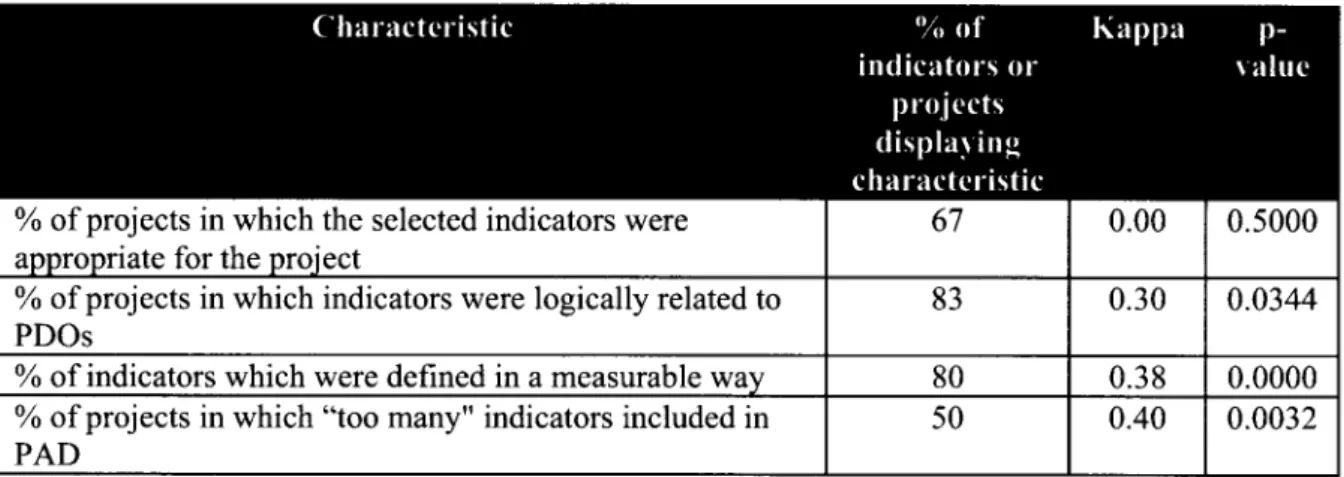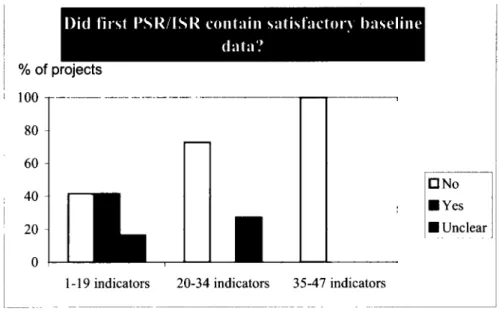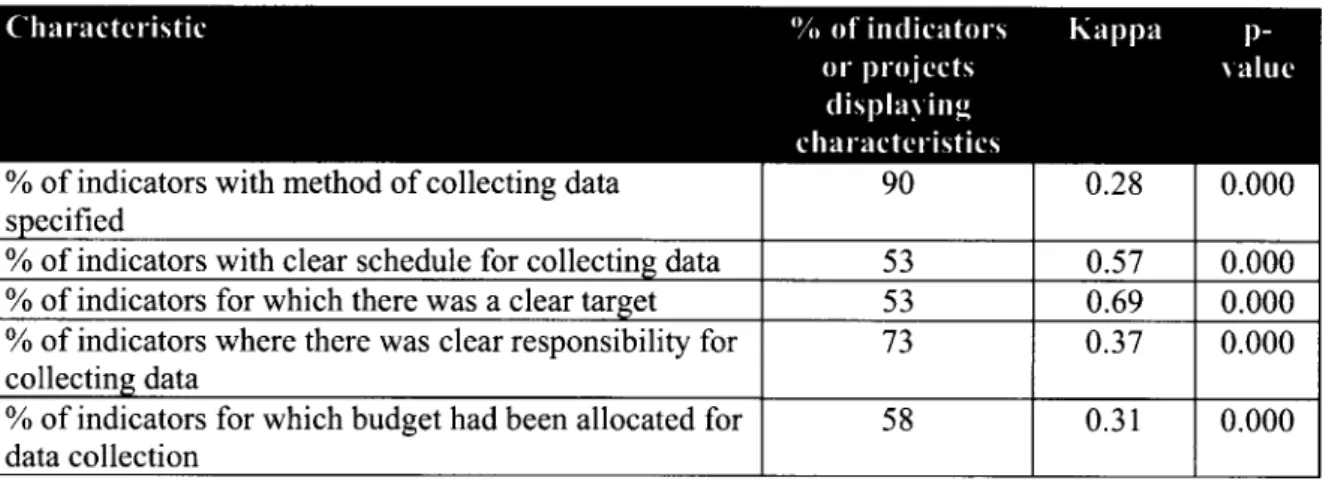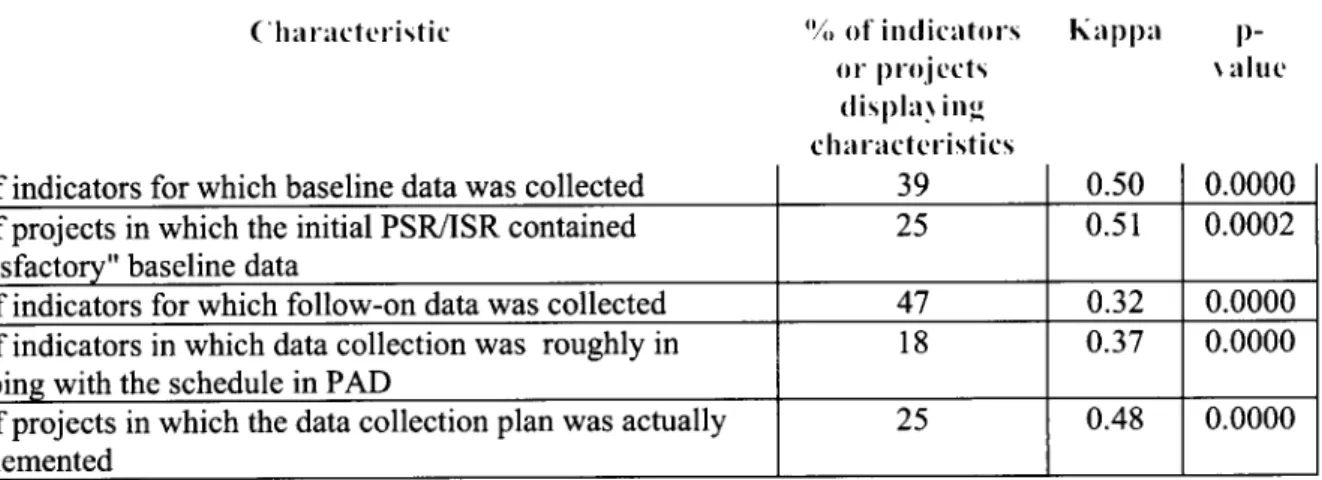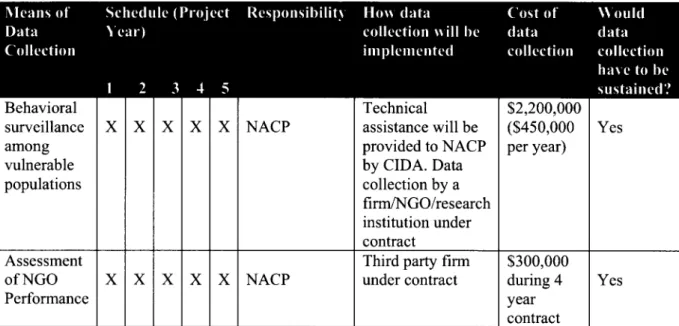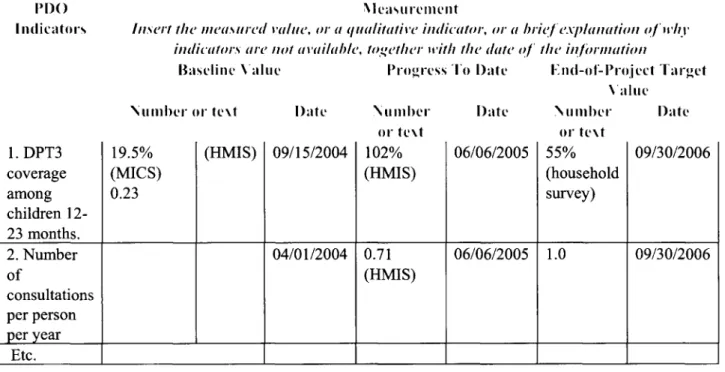co m)
4 4
00
rA.a
Uci
0- m D .
o LE
.-
4-'
Cl)M
o) Lf)
Public Disclosure Authorized Public Disclosure Authorized Public Disclosure Authorized
MEASURING RESULTS:
A REVIEW OF MONITORING AND EVALUATION IN HNP OPERATIONS IN SOUTH ASIA AND
SOME PRACTICAL SUGGESTIONS FOR IMPLEMENTATION
August 2006
THE WORLD BANK
SOUTH ASIA HUMAN DEVELOPMENT UNIT
ACKNOWLEDGEMENTS
This report was prepared by Benjamin Loevinsohn and Aakanksha Pande (SASHD- HNP). Shreelata Rao-Seshadri reviewed all project documents and made critical inputs to the writing of this report. A number of World Bank staff who provided useful comments to this report are gratefully acknowledged and include, Susan Stout, Martha Ainsworth, Edward Bos, Markus Goldstein, Keith Mackay, Barbara Kafka, Kees Kostermans, and Peter Berman. The authors are also grateful to the SASHNP task team leaders who were interviewed and shared their insights. This report was prepared under the overall guidance of Anabela Abreu and Julian Schweitzer.
The authors also wish to thank Silvia Albert who designed and edited this report.
Measuring Results: A Review of Monitofing and Evaluation in HINP Operations in South Asia and Some Practical Suggestions for Implementation
ACRONYMS AND ABBREVIATIONS CIDA Canadian International Development Agency CMUs Country Management Units
DEC Development Economics and Chief Economist DHS Demographic and Health Survey
DOs Development Objectives EOIs Expression of Interest
HMIS Health Management Information Systems HNP Health, Nutrition and Population
ICR Implementation Completion Report IDA International Development Association IEC Information, Education and Communication IMR Infant Mortality Rate
ISR Implementation Status Report M&E Monitoring and Evaluation MDG Millennium Development Goals MICS Multiple Cluster Information Surveys NACP National AIDS Control Program NGO Non-government Organization OED Operations Evaluation Department OPCS Operation Policy and Country Services PAD Project Appraisal Document
PDOs Project Development Objectives
PHRD Policy and Human Resources Development PRSP Poverty Reduction Strategy Paper
PSR Project Status Report QERs Quality at Entry Review RFP Request for Proposal
SASHD South Asia Human Development Sector
SASHNP South Asia Health, Nutrition, Population Sector TORs Terms of Reference
TTLs Task Team Leaders
U5MR Under Five Mortality Rate
Measuring Results: A Review of Monitoring and Evaluation in HNP Operations in South Asia and Some is Practical Suggestions for Implementation
CONTENTS
EXECUTIVE SUMMARY ... i
1. INTRODUCTION ... 1
A. Background ... 1
B. Objectives ... 2
2. METHODS ... 2
3. RESULTS ... 4
A. Selection and Definition of Indicators ... 4
B. Design of Data Collection ... 6
C. Implementation of the Data Collection Plans ... 8
D. Use and Analysis of Data ... 9
E. Building M&E Capacity ... 10
F. Impact Evaluation of Innovations ... 10
G. Progress on M&E Over Time ... 11
4. RECOMMENDATIONS ... 11
5. CHECKLIST FOR M&E IN HNP OPERATIONS ... 14
A. Introduction ... 14
B. Preparation and Appraisal ... 14
C. Implementation ... 20
Annex 1 ... 26
Measuring Results: A Review of Monitoring and Evaluation in HNP Operations in South Asia and Some El Practical Suggestions for Implementation
EXECUTIVE SUMMARY
1. Background: An assessment of monitoring and evaluation (M&E) was undertaken to learn lessons, both positive and negative, from the experience of SASHNP in ongoing or recently closed projects. The objectives of the study were to: (a) improve the design and implementation of M&E of Bank HNP operations in the region; (b) understand how to increase the number of impact evaluations of important innovations;
(c) figure out means to assist our clients to improve the monitoring of the performance of their health sectors; (d) further strengthen the "results" culture among sector staff; and (e) establish a baseline against to which judge progress on improving M&E that could be repeated in 2-3 years.
2. Methods: A randomly selected sample of twelve, regionally representative HNP projects were reviewed independently by three separate observers who used a standardized questionnaire to record data. The reviewers examined, in depth, the PAD, all the aides-memoire, all the PSRs/ISRs, and the ICR (if it had been completed). For each operation, five indicators were randomly selected from the results framework (what is now Annex 3) of the PAD for more detailed review. Qualitative interviews were also undertaken with selected TTLs. The inter-observer reliability of the findings was tested using the kappa statistic which determines whether the agreement among observers is more than could be expected due to chance.
3. Selection of Indicators: The agreement among the reviewers about whether the selected indicators were appropriate for the operation was no better than would be achieved by flipping a coin. This suggests that reasonable people can legitimately disagree about what constitutes a set of sensible indicators for an operation. However, there is likely room for improvement in indicator selection. Many of the indicators are
"upstream", i.e., they deal with inputs and processes rather than outputs and outcomes.
The mean number of indicators per operation was twenty six and some projects had many more. Not surprisingly, having more indicators leads to less data actually being collected.
4. Design of Data Collection: While the PADs often described important aspects of the indicators included in the results framework, only a third of the indicators had all the following characteristics: (a) they were defined in a measurable way; (b) had a clear method for collecting data; (c) had an explicit schedule for data collection; (d) had an explicit target; and (e) indicated who was responsible for collecting the data. There could have been greater use of household and health facility surveys to collect key data. Control or comparison groups were rarely used even when they existed and could have been used at modest cost. The use of controls has declined since before 2000.
5. Implementation of Data Collection: Baseline data was collected for only 39%
of the indicators studied, and only a quarter of the projects had "satisfactory" baseline
data in the initial PSR/ISR. The collection of follow-on data was equally poor and for
only a quarter of the operations studied was the data collection plan judged to have
-mostly" been implemented. A major issue identified in the review was that the approach
to data collection was inconsistent. For example, the sampling methodology or the questions asked would vary from survey to survey, making the trend data un- interpretable. Despite the problems, there were some projects that did a reasonable job of data collection indicating that this is possible to do under operational conditions.
6. Use and Analysis of Data: Because data collection was not often implemented, there was little opportunity for analysis of the data. However, even when data was collected, there was evidence of actual analysis of the data only half the time. Data analysis did not always lead to action. In those instances where data was collected for an indicator, there was evidence that the information resulted in some action only one quarter of the time.
7. Building M&E Capacity: There was little agreement among the reviewers about whether projects analyzed the capacity of clients or had plans for building that capacity.
This disagreement partly reflects the fact that there were few explicit mentions of M&E capacity building, although it was sometimes implied in the PAD. There were many projects which involved development of a computerized management information system but did not explicitly lay out plans for building M&E capacity.
8. Impact Evaluations of Innovations: Each project had on average two innovations that were described in the PAD. Unfortunately, there was very little agreement among the reviewers about whether a project included an innovation or whether there was a clear mechanism for assessing the effectiveness of the innovation.
There were certainly opportunities for controlled studies but these were rarely taken advantage of even when there was clear phasing of implementation or when the project did not cover all the districts or sub-districts.
9. Little Evidence of Improvement Over Time: There was little evidence that M&E improved from projects approved before the end of 2000 compared to projects approved after January 2001.
10. Recommendations: Based on the results of the review, discussions with sector staff, and comments from experts in the Bank, the following recommendations are made:
(a) task teams should routinely use an M&E checklist, such as the one attached to this
report; (b) M&E should be a central part of quality enhancement reviews (QERs); (c)
more technical assistance should be provided to task teams on M&E; (d) M&E capacity
of task teams should be further strengthened through focused and practical training; (e)
all aspects of M&E including building of client capacity, conducting of rigorous
evaluations, as well as effective M&E of the Bank operations themselves, need to be
dealt with but the first two appear to be receiving insufficient attention; (f) management
need to provide clear and consistent messages to staff about the importance of M&E; (g)
task teams and managers need to regularly review M&E during implementation; and (h)
one senior staff in the sector should devote part of their time to supporting M&E
activities and help implement the above recommendations.
Measuring Results: A Review of Monitoring and Evaluation in HNP Operations in South Asia and Some Practical Suggestions for Implementation
1. INTRODUCTION A. Background
1. Strong consensus on the importance of Measuring Results: There has been an increasing demand from shareholders and stakeholders for the Bank to do a better job on measuring results (often referred to as monitoring and evaluation [M&E]). The results framework for IDA-14 is an example of the increasing external pressure on the Bank to spend more time and effort on M&E. The management of SASHD has also consistently emphasized the importance of M&E. Based on discussions and interviews, it also appears that SASHNP staff are very interested in M&E and see it as key to successful operations and more broadly in making progress towards the Millennium Development Goals (MDGs). For more than a decade the Bank, as an institution, has continuously emphasized the importance of monitoring project performance and progress towards achievement of development objectives. Hence, it appears that there is a strong consensus on the centrality of M&E to the work of the Bank.
2. Different aspects of M&E: In spite of this consensus, there is a perception that the Bank's prior efforts to strengthen M&E have had modest effect, partly because the necessary resources have not been available and it has not received sufficient attention from managers and staff. In addition, the term M&E is loosely defined and often means different things to the various stakeholders involved. To avoid confusion, this report identifies three areas of M&E:
(a) M&E of Bank operations is the planned and systematic collection of data on selected indicators to determine whether the objectives of Bank lending operations have actually been achieved. This is a fiduciary responsibility for the Bank and its staff,
(b) Building client capacity for M&E which includes Bank efforts to build the capacity of national or local governments to use information to track and improve the performance of their health systems, including progress towards the MDGs, and important outputs like immunization coverage, etc.; and (c) Impact evaluation, which is the rigorous evaluation of innovative
approaches or policies to determine whether they actually have the intended effect.
3. Origins of the Study: This study arose out of the interest of SASHNP staff and
management who wanted to learn lessons, both positive and negative, about their
experience with M&E. The study received material and moral support from the Regional
Vice-President's Office. The willingness SASHNP staff to subject their M&E activities
to critical review reflected their belief that this would improve the services provided to
clients and enhance the health of beneficiaries. The Vice-President of OPCS recently
indicated that HNP generally has done a better job than other sectors in M&E. Hence, the
fact that this study focuses on HNP is not because the sector is particularly problematic on M&E or that South Asia is doing any worse than other regions. Rather, the current study signals the desire of SASHNP to get better at what it does and reflects consistent management commitment to this issue.
B. Objectives
4. The overall intent of this review was to strengthen M&E for HNP in South Asia by accomplishing the following specific objectives:
(a) Improve the design and implementation of M&E in Bank HNP operations in the region;
(b) Substantially increase the number of impact evaluations of HNP innovations and policies carried out with Bank support;
(c) Assist our client countries to do a better job of monitoring and evaluating the performance of their health sectors;
(d) Further strengthen the "results" culture among sector staff; and
(e) Establish a baseline against to which judge progress on improving M&E that could be repeated in 2-3 years.
2. METHODS
5. Basic Design: The assessment described here followed a written protocol that was reviewed by peers before it was implemented on a pilot basis. Three observers were involved in the review and, while all had considerable knowledge of M&E, they brought different backgrounds and experiences to the effort. The observers independently reviewed projects in detail using a standardized questionnaire (see the Annex) to record key information. For a total of twelve projects, the reviewers examined the PAD, all the aides memoire, all the PSRs or ISRs, and the ICR (where completed). Five individual indicators from each project (i.e., a total of 60) were randomly selected from the Results Framework (what is now Annex 3) of the PAD and subjected to detailed review. The reviewers also wrote on the questionnaire their opinions of certain aspects of the M&E process. After the review of three projects on a pilot basis, the questionnaire was slightly changed and used for the remainder of the assessment. As an additional, qualitative, input to the assessment, key informant interviews were conducted with task team leaders using a series of guide questions.
6. Scope: Information was collected on: (a) the selection of indicators and whether
they were explicit, measurable, and related to the objectives of the operation; (b) the data
collection plans that were developed for the operation; (c) whether the data collection
plans was actually implemented as designed; (d) whether operations have actually helped
countries to build M&E capacity; and (e) whether opportunities for impact evaluation
were taken advantage of.
Measuring Results: A Review of Monitoring and Evaluation in HNP Operations in South Asia and Some Practical Suggestions for Implementation
7. Inter-Observer Agreement and Validity: Many similar reviews are undertaken in the Bank but they rarely have multiple observers or measure inter-observer agreement.
This is a serious problem because inter-observer reliability is the sine qua non of validity.
If reasonable observers, examining the same characteristic of a project, cannot agree on whether it is present or not, then it generally makes little sense to draw definitive conclusions about that particular characteristic. For example, we found that different observers did not agree on whether the under-five mortality rate should have been included as an indicator in the projects reviewed (as suggested by IDA-14). Hence, we cannot conclude whether the under-five mortality rate should have been used in more projects or not.
8. The Kappa Statistic: We measured inter-observer reliability using the kappa statistic which measures agreement between observers above what would occur by chance. (For example, two weather forecasters living in the desert will agree on the forecast, and be right, if they keep on telling their viewers that "it will be hot and sunny tomorrow." This does not make them good weather forecasters nor does it indicate that their agreement on the forecast is better than would be expected due to chance alone.) Kappa varies from +1 (perfect agreement) to -1 (perfect disagreement) with kappas between 0 and 0.2 generally regarded as showing poor agreement, 0.21-0.40 deemed to show fair agreement, 0.41-0.60 moderate agreement, and kappas above 0.6 indicating substantial agreement. P-values can also be calculated for kappa and show whether the kappa is significantly different from 0, i.e., what would be expected due to chance.
9. Sampling: Twelve regionally representative projects were included in the review.
Three projects were selected purposefully for the pilot phase and included health system and disease control types of projects. The other nine projects included in the review were randomly selected from the pool of twenty seven ongoing operations or projects that had been completed since 2003. Since projects from India constituted 60% of that pool, it was decided that Indian projects would constitute seven of the twelve projects reviewed.' These projects were stratified to obtain a balance between state health systems projects and "vertical" or centrally sponsored schemes.
10. Analysis: Data from the completed questionnaires was analyzed using STATA.
Categorical data was analyzed by constructing frequency tables of the median of all three reviewers' responses for each question so as to obtain the majority opinion. Frequency tables were used to calculate the kappa statistics. The questionnaire, the data base, and the analyses are in IRIS to facilitate a follow-up study.
To avoid any bias, projects worked on by the reviewers were excluded from the study.
3
3. RESULTS A. Selection and Definition of Indicators
11. Uncertainty about the Selection of Indicators: Choosing the right indicators for an HNP operation appears to be a difficult task which involves a great deal of opinion. In response to the question, "overall, do you think the M&E indicators selected were appropriate for the operation as it was described in the PAD?" the reviewers level of agreement was no better than flipping a coin (i.e., the kappa was 0 and the p value was 50%, see Table 1). The lack of agreement suggests that in choosing indicators for an operation it is difficult to please everyone and that there is room for legitimate disagreement on what constitutes a set of sensible indicators. Choosing indicators may be more of an art than a science, however that does not mean that there is not room for improvement. There was better agreement on whether M&E indicators listed in the PAD logically related to the stated objectives of the operation. This suggests that the indicators may have been consistent with the stated project development objectives (DOs), but that the DOs may not have been appropriate for the project. This is consistent with a Bank- wide review recently carried out by the HNP hub.
12. Many Indicators are "Upstream": The reviewers often felt that the indicators selected were "upstream" i.e., more focused on inputs and processes rather than outputs or outcomes. For example in one project, one of the indicators in the PAD was the number of health workers trained on quality assurance methodologies. There were no indicators related to whether quality assurance mechanisms were actually implemented or whether quality of care had actually improved. This suggests that there is some disagreement on the extent to which upstream indicators should be included in the results framework.
13. TTLs Need to Keep a lot of People Happy: Discussions with TTLs also indicates that in selecting indicators, task teams face a number of challenges, including:
(a) governments do not take ownership of the process partly because they do not know
how to do it; (b) governments are usually held accountable only for inputs (with audits of
expenditures) so that monitoring outputs and outcomes is not a familiar concept; (c) there
are multiple requirements from inside the Bank; (d) ensuring consistency with the design
of the project and ensuring that the M&E is practical and can be implemented; and (e)
there is pressure from a variety of stakeholders to address global priorities such as the
MDGs.
Measuring Results: A Review of Monitoring and Evaluation in HNP Operations in South Asia and Some Practical Suggestions for Implementation
Table 1: Selection and Definition of Indicators
% of projects in which the selected indicators were 67 0.00 0.5000
appropriate for the project
% of projects in which indicators were logically related to 83 0.30 0.0344
PDOs
% of indicators which were defined in a measurable way 80 0.38 0.0000
% of projects in which "too many" indicators included in 50 0.40 0.0032
PAD -
Note: Kappas between 0 and 0.20 represent poor agreement, 0.21-0.40 fair agreement, 0.41-0.60 moderate agreement, and >0.61 substantial agreement.
14. Many Indicators are Chosen for Each Project: The mean number of M&E indicators per project identified in the Results Framework of the PAD was twenty six (the median was twenty three and the range was from five to forty seven). Half of the projects studied were believed to have too many indicators and there was fair agreement among the reviewers. For many of the projects, the list of indicators resembled a checklist of actions to be taken rather than a concise list of key objectives to be accomplished. The excessive number of indicators may again reflect the need of task teams to keep many interests happy. For some operations, the number of indicators was larger than those identified in the Results Framework, because different indicators were specified in multiple sections of the PAD. For example, in one project there were "technical and managerial indicators" specified in the main text; "social indicators" identified in one annex; information, education, and communication (IEC) indicators identified in another annex; and a table of "objectives and expected outcomes" in another annex which identified even more output and outcome indicators.
15. Having More Indicators Leads to Less Data: Not surprisingly, having more indicators for an operation appears to lead to less data actually being collected. Projects having more than the median number of indicators (i.e., twenty three or more) were less likely to have collected baseline data or follow-on data. For the indicators reviewed in detail, follow-on data was collected about half as frequently for projects with twenty four or more indicators (32% of indicators had follow-on data vs. 63% of the indicators in projects with fewer indicators). Similar findings apply for collection of baseline data as can be appreciated from Figure 1 which shows a nice gradient indicating that as the number of indicators increases the likelihood of satisfactory baseline data decreases.
5
Figure 1: Decrease in Data Collection as Number of Indicators Increases
% of projects
100 __ _
80- 60- 40 -ENYes ANo
20 3 U Unclear
0
1-19 indicators 20-34 indicators 35-47 indicators
16. Indicators are usually Defined in Measurable Way: Of the sixty randomly selected indicators reviewed in detail, 80% were "defined in such a way as to be measurable" and there was fair agreement among the reviewers. However, there were clear examples where the indicators, while addressing potentially important issues, could not have been measured. For example, in one project one of the indicators was: "licensing procedures and fee structures for service providers [will be] revised to support the ...
service package." In another project one of the key indicators was "the Government, in consultation with major stakeholders, develops recommendations and options for appropriate policies and measures for improving ... quality and safety in line with its new approach."
B. Design of Data Collection
17. Key Aspects of Data Collection Specified for Only a Third of Indicators: As mentioned above 80% of the indicators studied were defined in a measurable way. As can be seen in Table 2, task teams often provided important information on the indicators selected that helped in ensuring that data was collected and analyzed. For example, 90%
of the 60 indicators studied had a clear method for collecting information defined in the
PAD and for 73% it was clear who was responsible data collection. While task teams
clearly felt that describing these individual aspects of the indicators in the PAD was
important, only 33% of the indicators had all of the following elements: (a) they were
defined in a measurable way; (b) had a clear method for collecting data; (c) had an
explicit schedule for data collection; (d) had an explicit target; and (e) indicated who was
responsible for collecting the data.
Measuring Results: A Review of Monitoring and Evaluation in HNP Operations in South Asia and Some on Practical Suggestions for Implementation
Table 2: Design Features of M&E Indicators Reviewed in Detail (N=60)
% of indicators with method of collecting data 90 0.28 0.00
specified
% of indicators with clear schedule for collecting data 53 0.57 0.000
% of indicators for which there was a clear target 53 0.69 0.000
% of indicators where there was clear responsibility for 73 0.37 0.000 collecting data
% of indicators for which budget had been allocated for 58 0.31 0.000 data collection
Note: Kappas between 0 and 0.20 represent poor agreement, 0.21-0.40 fair agreement, 0.41-0.60 moderate agreement, and >0.61 substantial agreement.
18. Limited Use of Household and Health Facility Surveys: Household surveys can provide important information not easily available from other sources, such as: (a) equity in access to services; (b) use of private sector services; (c) prevalence data, such as the contraceptive prevalence rate or the occurrence of diarrhea; (d) community satisfaction; and (e) expenditures on health care. Such surveys can also be used to in concert with data from the health management information systems (HMIS) which usually collects data from the public sector. While HMISs can provide near real time information, they have often been found, in South Asia, to be inaccurate. Thus another use of household surveys can be to validate HMIS information. Despite their potential importance, there was limited use of household surveys. Only 13% of the indicators were to be measured using household surveys, although 18% of indicators were supposed to be measured using multiple methods which sometimes included household surveys.
Measuring quality of care almost always requires some form of health facility assessment, however only 2% of the indicators obtained information using this method.
The other sources of data for the indicators were 13% from HMIS; 32% from project records; 20% from other sources; and for 2% of indicators no method of data collection was specified.
19. Control/Comparison Groups Rarely Used Even When Available: For only 7%
of the indicators reviewed in detail was a control or comparison group identified in the PAD. However, for the remaining indicators, the reviewers felt that for at least one third it was possible to identify a control group (kappa = 0.32, p = 0.0000). One quarter of the operations studied were supposed to phase in activities over time (although in half the projects it was unclear whether there was phasing or not) and in about 58% of the operations not all the jurisdictions in the project area were covered. Thus it appears that there are more opportunities to have comparison or control groups by taking advantage of the project design. It appears that this could be done at modest cost.
20. Declining Use of Control Groups: There has been a declining trend over time in the use of control groups to measure the success of Bank operations. In projects approved
7
prior to 2000 about 16% of the indicators had control groups mentioned in the PAD. For projects approved since 2000, none of the indicators had clearly identified comparison
groups.
C. Implementation of the Data Collection Plans
21. Baseline Data Rarely Collected: Among the sixty randomly selected indicators studied in detail, baseline data was collected for only 39% of them (see Table 3). Among those indicators with baseline data, 67% of the data was stated in the PAD; 22% of the baseline data was collected between four months to one year after effectiveness; and for 11% of indicators with baseline data, it was collected more than two years after effectiveness. For one project "baseline" data became available almost five years after board approval. Due to delays in contracting a firm to undertake the baseline survey in another project, baseline data was available about two and one-half years after project effectiveness. Overall, only 25% of the operations reviewed had satisfactory baseline data prior to or included in the first ISR (an indicator in the IDA-14 results agreement). These findings are a little lower but comparable to a Bank-wide review of HNP projects which found that 47% of first ISRs have baseline data.
Table 3: Implementation of Data Collection Plans
C har acteristic "ou of in(licatri-s Kap pa p-
OP. projects . altie
dlisplaN ing' chal-ra cte ristics
